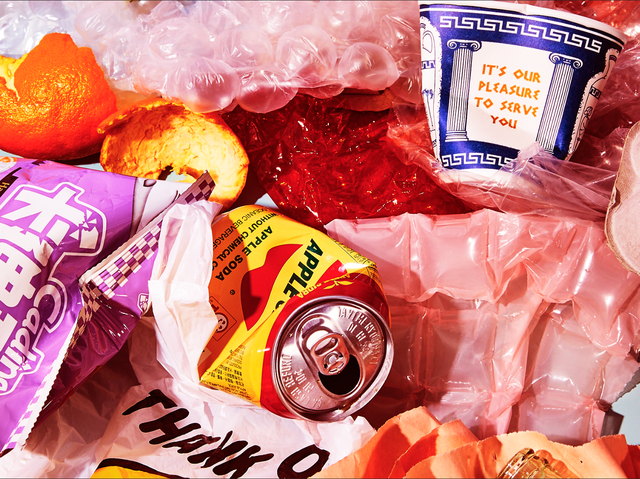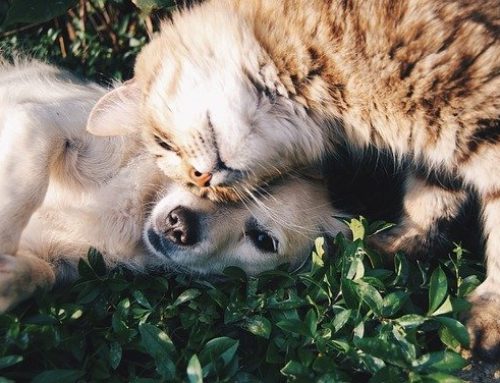The planet is in peril, and plastics are a major problem. Now there’s an entire movement dedicated to changing our habits before it’s too late. But how much good can an individual really do? Marie Claire investigates.
There’s a scene in The Graduate when Mr. McGuire tells Benjamin, “I want to say one word to you … plastics. There’s a great future in plastics.” I’ve been thinking about that line a lot lately because even though the film came out in 1967 and much about it doesn’t exactly hold up in 2019, nearly all of the plastics made that year (and, in fact, since 1950) are still hanging out in landfills. They’ll potentially be there for another several hundred years. Plastic was supposed to make our lives easier, but now it’s clogging our oceans (one study says that by 2050, there will be more plastic in the water than fish) and littering our streets and parks. The production of it is increasing carbon emissions by the ratio of about one ounce of CO2 to one ounce of plastic. Annually, emissions from plastic production alone can equal close to half of the emissions generated by the approximately 200 million licensed drivers in the U.S. You can try to recycle it, but 91 percent of all plastics aren’t recycled, instead getting either trashed or incinerated, according to a 2016 study. And, perhaps because they’re made from fossil fuels, they receive huge government subsidies, which might explain why plastic production is expected to account for 20 percent of global oil consumption by 2050. Plastic bags have even been found at the bottom of the Mariana Trench in the Pacific Ocean, the deepest point on Earth. More than literature or language or art, it seems that the human race’s legacy will be plastic—and it’ll carry on long after we’re gone.
The timing of all of this isn’t great for the U.S. in particular, since we have one of the biggest carbon footprints per capita of any nation, rivalling those of India and China, those oft-blamed carbon boogeymen. A 2018 U.N. report gave the planet’s inhabitants a little over a decade to decrease our carbon emissions before the catastrophic effects of climate change will become irreversible. While the report seems to have created an uptick in concern for the environment (Democratic voters now say climate change is one of their top concerns for the future), the Trump administration doesn’t seem to care: It announced plans to pull the U.S. out of the Paris climate accord, it’s rolling back protections on national parks to open them up for drilling, and it even struck the phrase “climate change” from several federal websites.
Plastic is just the tip of the rapidly melting iceberg that is our climate-change problem, with deforestation, coal and gas burning, and wide-scale factory farming adding to the buffet of horrors. But tackling our reliance on plastic could be a way to gain some individual control at a time when expecting the government to provide guidance seems like a nonstarter.
Enter the zero-waste lifestyle movement, which is steadily gaining momentum. Though it’s not new—the 2009 documentary No Impact Man followed writer Colin Beavan in his attempt to give up practically all electricity and forgo single-use plastics for a year—it’s now attracting a new wave of acolytes who tout the benefits of their lifestyle on Instagram.
Its goal is straightforward: Reduce the items in your life so you can either reuse or compost everything without creating excess trash. Most of this is accomplished by toting reusable containers, buying clothing secondhand, growing a garden and buying food in bulk, avoiding unnecessary purchases or ones that come with excess packaging (especially if it’s plastic), and using leftover organic waste for gardening. Some of the best-known practitioners don’t even count recycling as zero waste because it’s not always clear where those plastics are going (and the countries we used to send our plastics to, like China and Malaysia, are increasingly turning them away). Perhaps you’ve seen stories about people who can fit all of their trash for a year into a single mason jar? That’s zero waste in its purest, most visually pleasing form. And some of the stars of the movement—like Lauren Singer, of the Instagram account @trashisfortossers, and Bea Johnson, the author of Zero Waste Home—have garnered hundreds of thousands of social-media followers, all seeking to learn from their chic, clean, environmentally friendly lifestyle.
That zero waste is gaining popularity right now is unsurprising: Aside from its perceived environmental benefits, it’s a way to become more self-reliant, live with less, and gain control over consumption and spending. It even has a hint of the trendy Marie Kondo–inspired minimalist aesthetic. Plus, you can feel like you’re doing something for the planet instead of just watching it burn.
I thought I would try it. But like learning Mandarin or reading the complete works of Tolstoy, going zero waste is impressive, has great benefits, and seems utterly implausible for most Americans. And because it’s seemingly hard to do, the movement’s proliferation on social media might even come off as virtue signaling, the performative “Aren’t I so considerate of the environment?” braggadocio belying the capital-I Important work.
And yet, to hear it from the zero-wasters themselves, it’s not supposed to look aspirational. Their accounts aim to make going trash-free seem like something anyone can pick up. I called Bea Johnson, the aforementioned author and mastermind of the @zerowastehome Instagram (which had 221,000 followers at the time of publication), to ask how she does it. She makes the lifestyle look totally inspirational, traveling the world giving lectures on the movement and even delivering TEDx talks about it. She’s also the one credited with first using the term “zero waste,” which had traditionally been applied to manufacturing and municipal practices, to describe the trash-free lifestyle.
In some ways, Johnson represents what’s unattainable about zero waste—she’s a gorgeous French woman who shares her immaculate California home with two kids and a husband who all manage to make their lives trash-free too—but in others, she’s surprisingly relatable. For instance, she explains that when she first adopted the lifestyle in 2006, she was so gung ho that she hardly had time for anything else. “I was making my own bread, my own cheese, my own butter, my own soy milk,” she says. “There was just no way that I could stick to making all these things for life, and it dawned on me that if my family and I really wanted this lifestyle to be sustainable—to be something that we can stick to in the long run—then we had to find a simple system that we could see ourselves doing forever.” So she decided to let zero waste make her life less complicated. She stopped making her own cheese and now buys bread, which she brings home in a repurposed pillowcase. (“They make it so much better than I do,” she says.) She appreciates how zero waste allows her family to focus on experiences and time together rather than the accumulation of things.
Anne-Marie Bonneau, another big-time zero-waster who goes by @zerowastechef on social media, is beloved in the movement for her practical approach. One of her most quoted sayings is “We don’t need a handful of people doing zero waste perfectly. We need millions of people doing it imperfectly.”
Bonneau tells me, “You can’t win anybody over if you’re preachy. Start with one thing, get that down, and then try another. If you drink a lot of bottled water, stop drinking bottled water. And then you’ll see, Hey, this isn’t that hard; I can carry a water bottle with me or drink from the fountain at the gym. You can’t change it all overnight. I think that just leads to frustration.”
Anne Loos, a 27-year-old graduate student living in Austin, has been trying to go zero waste for about six months. She packs her lunches in reusable jars and bags, buys bulk at her local co-op, and avoids eating out if it means she’ll have to throw away a bunch of food containers. Even so, she says she doesn’t want to throw away all of her nonrecyclables and start over with reusables because it seems antithetical. “I know I’ll eventually have to throw out certain products that I’m trying to go through right now before I switch to a zero-waste one,” she says.
It’s an important point: One of the (many) things zero-wasters preach is not throwing away one consumer habit for another. The key to the movement is reusing what you already have in creative ways until it’s lived out its usefulness rather than buying even more things. Loos says there are areas for improvement—for instance, she feels guilty when she forgets her thermos and has to buy coffee in a paper cup—but that she’s already starting to think about her trash differently. “If I just focus on the negatives, it’ll make me not want to keep going,” she says. “I try to just say to myself, okay, this doesn’t feel as good as not creating waste, so use this as a way to change your behavior. Turn the negative into a positive.”
It’s not lost on naysayers—or zero-wasters themselves—that women are the ones pushing the movement forward. Many an article has been written about how the women of zero waste may face a kind of “double burden”—the secondary work, like chores and cooking, that women are expected to do on top of their actual jobs. And though a few of the zero-wasters I spoke to lauded the lifestyle for its money-saving potential, getting there requires a ton of time and planning.
Johnson, who tells me that the majority of her followers are women between the ages of 25 and 34, says there’s logic to this. “Women today have to juggle careers, house maintenance, children,” she says. “And because traditionally”—her tone suggests scare quotes—“women are the ones taking care of the grocery shopping and the cleaning, today they have to juggle all those things. They’re looking for ways to be more efficient, to simplify their tasks, and I think zero waste does that for them.” Plus, there’s a biological reason for it: “That’s the age when women become pregnant, and you want the best future for your baby. You’re paying attention to the things you’re putting in your body and to the environment you’re going to bring him up in.”
Loos thinks society also plays a role in why women are drawn to zero waste. “I feel like women have a relationship to consumer culture that’s very different,” she says. “Marketing kind of preys on our insecurities about our image—as in, ‘You need all these products because otherwise you’ll be ugly and then you’re worth nothing. Your value to society is lessened’—in a way that it isn’t for men.” She says that by being conscious of what she purchases, she’s more comfortable resisting the urge to buy things because of what they would say about her. “That’s the thing about zero waste: It plays into so many things about consumer culture and marketing and capitalism,” she adds. “Since I’ve been making this kind of transition, I think about how all these things intersect a lot more.”
But if zero waste started in the home, it’s not ending there. Recently, major brands like PepsiCo, Unilever, and Nestlé have started rolling out reusable, refillable glass and steel containers for some of their products in an effort to cut back on single-use plastics. And all over the world, plastic-bag bans are gaining momentum. Just this year, Mexico City—one of the cities that produces the most trash in the world—passed a law banning certain kinds of single-use plastic. China and Australia have similar bans, as do California, Hawaii, and New York, plus a few major cities, like Chicago and Seattle.
There’s still a long way to go in combating climate change effectively—and it doesn’t help that just 100 companies, all of them in fossil fuels, account for 71 percent of all greenhouse-gas emissions—but the more I learn about zero waste, the more it makes sense. It’s hard to tell if this movement could create a quantitative difference in how much plastic goes into landfills, but it asks us to consider our impact, and changing minds could empower people to make better, more environmentally friendly decisions in other areas of our lives. And if there is some virtue signaling going on, is that such a bad thing? Sure, some of these influencers’ lifestyles seem unattainable, but it’s a bit insulting to assume that the hundreds of thousands of women watching them won’t recognize the benefits of reducing waste just because they can’t fit their yearly trash into a jar. In the same way that eating one less burger per week is the equivalent of saving 320 miles’ worth of gasoline, imagine what the impact would be if a few million people stopped accepting plastic bags at the grocery store, or throwing away their takeout containers, or using plastic straws. That’s scalable change.
It’s reassuring that our efforts don’t have to be perfect. While working on this story, I decided to see how far I could get with zero waste myself in a way that actually made sense. I didn’t want to buy a slew of new jars, produce bags, and reusable straws, so I went mostly with what I already had, which turned out to be a lot once I cleaned out the fridge. I started a little compost bin in my freezer, which I empty out at the farmers’ market on Saturdays (and I also do more shopping there, with reusable totes, no less!), and got a membership to the local co-op so I can start buying in bulk. I bring reusable dishware to work, and I’m cooking instead of ordering takeout. And while doing that takes a little bit of extra time per week, aren’t we in this mess because we chose convenience over responsibility to the planet? I probably won’t get to trash-in-a-jar levels anytime soon, but I’m thinking much more about the plastic that I use every day, and my garbage output is noticeably smaller after only a few weeks.
I know we’re talking about one woman’s trash and that deciding not to order Seamless one night isn’t a massive change in the grand scheme of sustainability. But more than anything else, taking steps to make my life a little bit more carbon neutral has made me optimistic about what else we can do to put the planet on the right course. If everyone changes a little, we could actually fix this problem. And we can start by just using fewer straws.
This story originally appeared in the August 2019 issue of Marie Claire.
This article was originally sourced from here.






